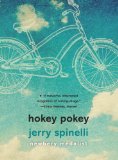Summary | Excerpt | Reviews | Beyond the Book | Read-Alikes | Genres & Themes | Author Bio

Critics' Opinion:
Readers' Opinion:
First Published:
Jan 2013, 304 pages
Paperback:
Apr 2014, 320 pages
 Book Reviewed by:
Book Reviewed by:
Tamara Ellis Smith
Buy This Book
This article relates to Hokey Pokey
You put your right foot in
You put your right foot out
You put your right foot in
And you shake it all about.
You do the Hokey Pokey
And you turn yourself around
That's what it's all about!
The Hokey Pokey is a timeless circle game, played by millions of children in millions of circles across many, many miles. But where did it come from? How did it start?
 The Hokey Pokey (known as such in the United States, Canada, Ireland and Australia, known as Hokey Cokey in the U.K., and Hokey Tokey in New Zealand) is a circle dance, in which the participants sing the song (see above) and follow the lyrics, putting different parts of the body into the circle when instructed to do so. The Hokey Pokey appears to have a few possible places of origin.
The Hokey Pokey (known as such in the United States, Canada, Ireland and Australia, known as Hokey Cokey in the U.K., and Hokey Tokey in New Zealand) is a circle dance, in which the participants sing the song (see above) and follow the lyrics, putting different parts of the body into the circle when instructed to do so. The Hokey Pokey appears to have a few possible places of origin.
The first was in wartime London. Supposedly a Canadian army officer suggested that Al Tabor, a British bandleader during the 1920-50s, write a party song. Al Tabor wrote it in 1942, and titled the song Hokey Pokey, based on a childhood memory he had of an ice cream vendor calling out: Hokey pokey penny a lump! Have a lick make you jump! Tabor changed the name from Pokey to Cokey on the suggestion of the officer who said it would sound better. Speaking of ice cream, one theory suggests that the words Hokey Pokey came from the Italian ecco un poco which means here is a little and was used by the Italian ice cream vendors who sold bits of ice cream wrapped in waxed paper.
But others suggest that Irish songwriter and publisher Jimmy Kennedy (who is known for The Teddy Bear's Picnic) created the song and dance in 1942 to entertain Canadian soldiers stationed in London.
Another theory is that the song originated in the United States – in Scranton, PA to be exact. Two musicians, Robert Degan and Joe Brier, supposedly created the song and dance in 1946 to entertain vacationers in the Poconos Mountains Resorts.
Yet another theory is that the term Hokey Cokey came from hocus pocus, the familiar chant that a magician utters as he does his tricks. This term was created as a mockery of the Latin term hoc corpus meum, which describes the Catholic Mass communion bread becoming the body of Jesus Christ.
Finally, others have suggested that the song comes from a Shaker song called Hinkum Booby. It was heard as early as 1857, supposedly sung by two sisters on a visit to Bridgewater, NH, from Canterbury, England. It was published in Edward Deming Andrews' book, The Gift to be Simple: Songs, Dances and Rituals of the American Shakers and goes like this:
I put my right hand in,
I put my right hand out,
I give my right hand a shake, shake, shake and I
Turn myself about.
Circling back to ice cream, there is the New Zealand-based Hokey Pokey ice cream, which is vanilla with honeycomb toffee. Incidentally Hokey Pokey is the Cornish term for honeycomb. My New Zealand friend – who used to live in NYC and now lives on the west coast of Canada – constantly laments that he can't get any of this delicious treat where he lives. I found a recipe for the "hokey pokey" part of the ice cream here. I am tempted to try it!
Picture from mentalfloss.com
Filed under Cultural Curiosities
![]() This "beyond the book article" relates to Hokey Pokey. It originally ran in January 2013 and has been updated for the
April 2014 paperback edition.
Go to magazine.
This "beyond the book article" relates to Hokey Pokey. It originally ran in January 2013 and has been updated for the
April 2014 paperback edition.
Go to magazine.





The House on Biscayne Bay
by Chanel Cleeton
As death stalks a gothic mansion in Miami, the lives of two women intertwine as the past and present collide.

The Flower Sisters
by Michelle Collins Anderson
From the new Fannie Flagg of the Ozarks, a richly-woven story of family, forgiveness, and reinvention.

The Funeral Cryer by Wenyan Lu
Debut novelist Wenyan Lu brings us this witty yet profound story about one woman's midlife reawakening in contemporary rural China.
Your guide toexceptional books
BookBrowse seeks out and recommends the best in contemporary fiction and nonfiction—books that not only engage and entertain but also deepen our understanding of ourselves and the world around us.